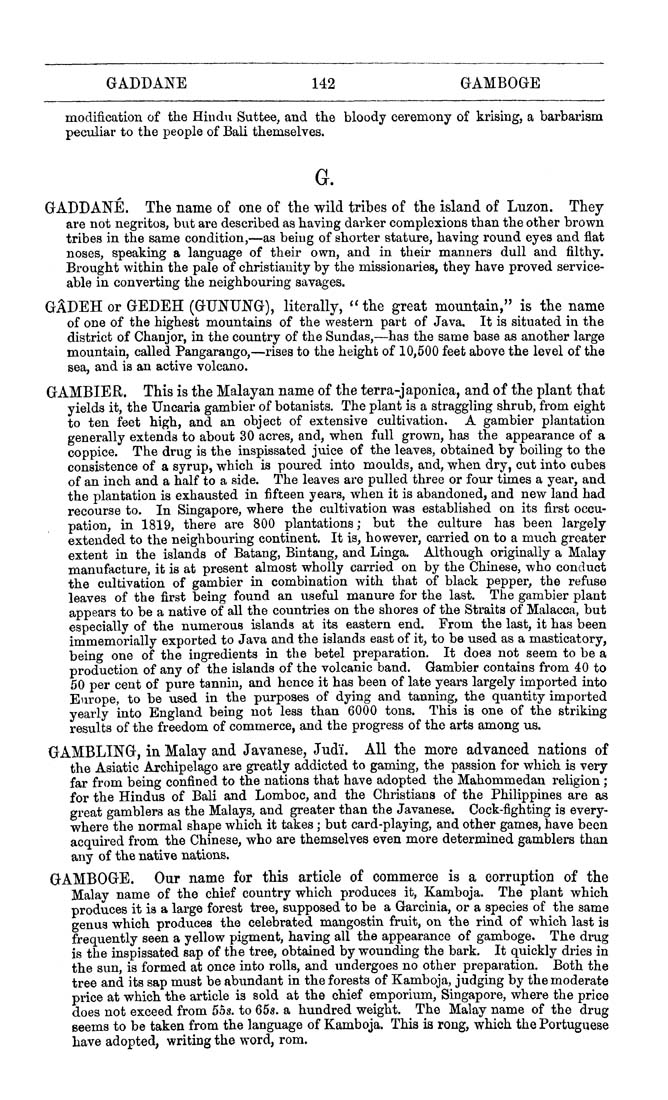GADDANE 142 GAMBOGE
modification of the Hindu Suttee, and the bloody ceremony of krising, a barbarism
peculiar to the people of Bali themselves.
G.
GADDANE. The name of one of the wild tribes of the island of Luzon. They
are not negritos, but are described as having darker complexions than the other brown
tribes in the same condition,—as being of shorter stature, having round eyes and flat
noses, speaking a language of their own, and in their manners dull and filthy.
Brought within the pale of Christianity by the missionaries, they have proved service¬
able in converting the neighbouring savages.
GADEH or GEDEH (GUNUNG), literally, *'the great mountain," is the name
of one of the highest mountains of the western part of Java. It is situated in the
district of Chanjor, in the country of the Sundas,—has the same base as another large
mountain, called Pangarango,—rises to the height of 10,500 feet above the level of the
sea, and is an active volcano.
GAMBIER. This is the Malayan name of the terra-japonica, and of the plant that
yields it, the Uncaria gambler of botanists. The plant is a straggling shrub, from eight
to ten feet high, and an object of extensive cultivation. A gambler plantation
generally extends to about 30 acres, and, when full grown, has the appearance of a
coppice. The drug is the inspissated juice of the leaves, obtained by boiling to the
consistence of a syrup, which is poured into moulds, and, when dry, cut into cubes
of an inch and a half to a side. The leaves are pulled three or four times a year, and
the plantation is exhausted in fifteen years, when it is abandoned, and new land had
recourse to. In Singapore, where the cultivation yp^as established on its first occu¬
pation, in 1819, there are 800 plantations; but the culture has been largely
extended to the neighbouring continent. It is, however, carried on to a much greater
extent in the islands of Batang, Bintang, and Linga. Although originally a Malay
manufacture, it is at present almost wholly carried on by the Chinese, who conduct
the cultivation of gambler in combination with that of black pepper, the refuse
leaves of the first being found an useful manure for the last. The gambier plant
appears to be a native of all the countries on the shores of the Straits of Malacca, but
especially of the numerous islands at its eastern end. From the last, it has been
immemorially exported to Java and the islands east of it, to be used as a masticatory,
being one of the ingredients in the betel preparation. It does not seem to be a
production of any of the islands of the volcanic band. Gambier contains from 40 to
50 per cent of pure tannin, and hence it has been of late years largely imported into
Europe, to be used in the purposes of dying and tanning, the quantity imported
yearly into England being not less than 6000 tons. This is one of the striking
results of the freedom of commerce, and the progress of the arts among us.
GAMBLING, in Malay and Javanese, Judi'. All the more advanced nations of
the Asiatic Archipelago are greatly addicted to gaming, the passion for which is very
far from being confined to the nations that have adopted the Mahommedan religion;
for the Hindus of Bali and Lomboc, and the Christians of the Philippines are as
great gamblers as the Malays, and greater than the Javanese. Cock-fighting is every¬
where the normal shape which it takes; but card-playing, and other games, have been
acquired from the Chinese, who are themselves even more determined gamblers than
any of the native nations.
GAMBOGE. Our name for this article of commerce is a corruption of the
Malay name of the chief country which produces it, Kamboja. The plant which
produces it is a large forest tree, supposed to be a Garcinia, or a species of the same
genus which produces the celebrated mangostin fruit, on the rind of which last is
frequently seen a yellow pigment, having all the appearance of gamboge. The drug
is the inspissated sap of the tree, obtained by wounding the bark. It quickly dries in
the sun, is formed at once into rolls, and undergoes no other preparation. Both the
tree and its sap must be abundant in the forests of Kamboja, judging by the moderate
price at which the article is sold at the chief emporium, Singapore, where the price
does not exceed from 55s. to 65s. a hundred weight. The Malay name of the drug
seems to be taken from the language of Kamboja. This is rong, which the Portuguese
have adopted, writing the word, rom.
|








